Macrobiotus rebecchii sp. nov.: A New Limno-Terrestrial and Hermaphroditic Tardigrade from Kyrgyzstan
Abstract
Simple Summary
Abstract
1. Introduction
2. Material and Methods
2.1. Sample Processing
2.2. Microscopy and Imaging
2.3. Morphometrics and Morphological Nomenclature
2.4. Genotyping
2.5. Morphological and Genetic Comparisons
3. Results
3.1. Description of the New Species
3.1.1. Taxonomic Account
3.1.2. Material Examined
3.1.3. Type Locality
3.1.4. Etymology
3.1.5. Type Depositories
3.1.6. Animals
3.1.7. Eggs
3.1.8. Reproduction
3.1.9. DNA Sequences and Comparison with Other Species
4. Discussion
5. Conclusions
Supplementary Materials
Funding
Institutional Review Board Statement
Informed Consent Statement
Data Availability Statement
Acknowledgments
Conflicts of Interest
References
- Guidetti, R.; Bertolani, R. Tardigrade taxonomy: An updated check list of the taxa and a list of characters for their identification. Zootaxa 2005, 845, 1. [Google Scholar] [CrossRef]
- Degma, P.; Guidetti, R. Notes to the current checklist of Tardigrada. Zootaxa 2007, 1579, 41–53. [Google Scholar] [CrossRef]
- Degma, P.; Guidetti, R. Actual Checklist of Tardigrada Species; 2009–2022, Ver. 41: 16-05-2022; Università di Modena e Reggio Emilia: Modena, Italy, 2019. [Google Scholar] [CrossRef]
- Nelson, D.R.; Bartels, P.J.; Guil, N. Tardigrade Ecology. In Water Bears: The Biology of Tardigrades; Schill, R.O., Ed.; Springer: Cham, Switzerland, 2018; pp. 163–210. [Google Scholar] [CrossRef]
- Vecchi, M.; Ferrari, C.; Stec, D.; Calhim, S. Desiccation risk favours prevalence and diversity of tardigrade communities and influences their trophic structure in alpine ephemeral rock pools. Hydrobiologia 2022, 849, 1995–2007. [Google Scholar] [CrossRef]
- Zawierucha, K.; Kolicka, M.; Takeuchi, N.; Kaczmarek, Ł. What animals can live in cryoconite holes? A faunal review. J. Zool. 2014, 295, 159–169. [Google Scholar] [CrossRef]
- Tumanov, D.V. Isohypsibius borkini, a new species of Tardigrada from Tien Shan (Kirghizia) (Eutardigrada: Hypsibiidae). Genus 2003, 14, 439–441. [Google Scholar]
- Tumanov, D.V. Two new species of Macrobiotus (Eutardigrada, Macrobiotidae) from Tien Shan (Kirghizia), with notes on Macrobiotus tenuis group. Zootaxa 2005, 1043, 33–46. [Google Scholar] [CrossRef]
- Tumanov, D. Five new species of the genus Milnesium (Tardigrada, Eutardigrada, Milnesiidae). Zootaxa 2006, 1122, 1–23. [Google Scholar] [CrossRef]
- Tumanov, D.V. Three new species of Macrobiotus (Eutardigrada, Macrobiotidae, tenuis-group) from Tien Shan (Kirghizia) and Spitsbergen. J. Limnol. 2007, 66 (Suppl. S1), 40–48. [Google Scholar] [CrossRef]
- Kaczmarek, Ł.; Zawierucha, K.; Buda, J.; Stec, D.; Gawlak, M.; Michalczyk, Ł.; Roszkowska, M. An integrative redescription of the nominal taxon for the Mesobiotus harmsworthi group (Tardigrada: Macrobiotidae) leads to descriptions of two new Mesobiotus species from Arctic. PLoS ONE 2018, 13, e0204756. [Google Scholar] [CrossRef]
- Coughlan, K.; Michalczyk, Ł.; Stec, D. Macrobiotus caelestis sp. nov., a New Tardigrade Species (Macrobiotidae: Hufelandi Group) from the Tien Shan Mountains (Kyrgyzstan). Ann. Zool. 2019, 69, 499. [Google Scholar] [CrossRef]
- Gąsiorek, P.; Michalczyk, Ł. Revised Cornechiniscus (Heterotardigrada) and new phylogenetic analyses negate echiniscid subfamilies and tribes. R. Soc. Open Sci. 2020, 7, 200581. [Google Scholar] [CrossRef] [PubMed]
- Gąsiorek, P. Water bear with barbels of a catfish: A new Asian Cornechiniscus (Heterotardigrada: Echiniscidae) illuminates evolution of the genus. Zool. Anz.—A J. Comp. Zool. 2022, 300, 47–64. [Google Scholar] [CrossRef]
- Zawierucha, K.; Stec, D.; Lachowska-Cierlik, D.; Takeuchi, N.; Li, Z.; Michalczyk, Ł. High Mitochondrial Diversity in a New Water Bear Species (Tardigrada: Eutardigrada) from Mountain Glaciers in Central Asia, with the Erection of a New Genus Cryoconicus. Ann. Zool. 2018, 68, 179–201. [Google Scholar] [CrossRef]
- Vicente, F.; Michalczyk, Ł.; Kaczmarek, Ł.; Boavida, M.-J. Observations on Pyxidium tardigradum (Ciliophora), a protozoan living on Eutardigrada: Infestation, morphology and feeding behaviour. Parasitol. Res. 2008, 103, 1323–1331. [Google Scholar] [CrossRef] [PubMed]
- Morek, W.; Surmacz, B.; Michalczyk, Ł. Novel integrative data for two Milnesium Doyère, 1840 (Tardigrada: Apochela) species from Central Asia. Zoosystematics Evol. 2020, 96, 499–514. [Google Scholar] [CrossRef]
- Stec, D.; Vecchi, M.; Calhim, S.; Michalczyk, Ł. New multilocus phylogeny reorganises the family Macrobiotidae (Eutardigrada) and unveils complex morphological evolution of the Macrobiotus hufelandi group. Mol. Phylogenetics Evol. 2020, 160, 106987. [Google Scholar] [CrossRef]
- Stec, D.; Vončina, K.; Kristensen, R.M.; Michalczyk, Ł. The Macrobiotus ariekammensis species complex provides evidence for parallel evolution of claw elongation in macrobiotid tardigrades. Zool. J. Linn. Soc. 2022, 195, 1067–1099. [Google Scholar] [CrossRef]
- Maucci, W.; Ramazzotti, G. Cornechiniscus gen. nov.: Nuova posizione sistematica per I cosiddetti ‘Pseudechiniscus gruppo cornutus’, con descrizione di una nuova specie (Tardigrada, Echiniscidae). Mem. Dell’istituto Ital. Di Idrobiol. 1981, 39, 147–151. [Google Scholar]
- Richters, F. Antarktische Tardigraden. Zool. Anz. 1907, 31, 915–916. [Google Scholar]
- Ramazzotti, G. Nuova varietà del Tardigrado Pseudechinsicus cornutus. Riv. Ital. Di Sci. Nat. 1943, 34, 89–90. [Google Scholar]
- Stec, D.; Smolak, R.; Kaczmarek, Ł.; Michalczyk, Ł. An integrative description of Macrobiotus paulinae sp. nov. (Tardigrada: Eutardigrada: Macrobiotidae: hufelandi group) from Kenya. Zootaxa 2015, 4052, 501–526. [Google Scholar] [CrossRef]
- Coughlan, K.; Stec, D. Two new species of the Macrobiotus hufelandi complex (Tardigrada: Eutardigrada: Macrobiotidae) from Australia and India, with notes on their phylogenetic position. Eur. J. Taxon. 2019, 573, 1–38. [Google Scholar] [CrossRef]
- Stec, D.; Gąsiorek, P.; Morek, W.; Kosztyła, P.; Zawierucha, K.; Michno, K.; Kaczmarek, Ł.; Prokop, Z.M.; Michalczyk, Ł. Estimating optimal sample size for tardigrade morphometry. Zool. J. Linn. Soc. 2016, 178, 776–784. [Google Scholar] [CrossRef]
- Michalczyk, Ł.; Kaczmarek, Ł. A description of the new tardigrade Macrobiotus reinhardti (Eutardigrada: Macrobiotidae, harmsworthi group) with some remarks on the oral cavity armature within the genus Macrobiotus Schultze. Zootaxa 2003, 331, 1–24. [Google Scholar] [CrossRef]
- Kaczmarek, Ł.; Michalczyk, Ł. The Macrobiotus hufelandi group (Tardigrada) revisited. Zootaxa 2017, 4363, 101–123. [Google Scholar] [CrossRef]
- Kaczmarek, Ł.; Cytan, J.; Zawierucha, K.; Diduszko, D.; Michalczyk, Ł. Tardigrades from Peru (South America), with descriptions of three new species of Parachela. Zootaxa 2014, 3790, 357–379. [Google Scholar] [CrossRef]
- Kiosya, Y.; Pogwizd, J.; Matsko, Y.; Vecchi, M.; Stec, D. Phylogenetic position of two Macrobiotus species with a revisional note on Macrobiotus sottilei Pilato, Kiosya, Lisi & Sabella, 2012 (Tardigrada: Eutardigrada: Macrobiotidae). Zootaxa 2021, 4933, 113–135. [Google Scholar] [CrossRef]
- Pilato, G. Analisi di nuovi caratteri nello studio degli Eutardigradi. Animalia 1981, 8, 51–57. [Google Scholar]
- Michalczyk, Ł.; Kaczmarek, Ł. The Tardigrada Register: A comprehensive online data repository for tardigrade taxonomy. J. Limnol. 2013, 72, e22. [Google Scholar] [CrossRef]
- Bertolani, R.; Guidetti, R.; Marchioro, T.; Altiero, T.; Rebecchi, L.; Cesari, M. Phylogeny of Eutardigrada: New molecular data and their morphological support lead to the identification of new evolutionary lineages. Mol. Phylogenetics Evol. 2014, 76, 110–126. [Google Scholar] [CrossRef]
- Casquet, J.; Thébaud, C.; Gillespie, R.G. Chelex without boiling, a rapid and easy technique to obtain stable amplifiable DNA from small amounts of ethanol-stored spiders. Mol. Ecol. Resour. 2011, 12, 136–141. [Google Scholar] [CrossRef] [PubMed]
- Stec, D.; Kristensen, R.M.; Michalczyk, Ł. An integrative description of Minibiotus ioculator sp. nov. from the Republic of South Africa with notes on Minibiotus pentannulatus Londoño et al., 2017 (Tardigrada: Macrobiotidae). Zool. Anz.—A J. Comp. Zool. 2020, 286, 117–134. [Google Scholar] [CrossRef]
- Hall, T.A. BioEdit: A user-friendly biological sequence alignment editor and analysis program for Windows 95/98/NT. In Nucleic Acids Symposium Series; Information Retrieval Ltd.: London, UK, 1999; Volume 41, pp. 95–98. [Google Scholar]
- Astrin, J.J.; Stüben, P.E. Phylogeny in cryptic weevils: Molecules, morphology and new genera of western Palaearctic Cryptorhynchinae (Coleoptera:Curculionidae). Invertebr. Syst. 2008, 22, 503–522. [Google Scholar] [CrossRef]
- Stec, D.; Zawierucha, K.; Michalczyk, Ł. An integrative description of Ramazzottius subanomalus (Biserov, 1985 (Tardigrada) from Poland. Zootaxa 2017, 4300, 403–420. [Google Scholar] [CrossRef]
- Pilato, G.; Binda, M.G. Descrizione du una nuova specie di Eutardigrado d‘Australia Macrobiotus joannae n. sp. Animalia 1983, 10, 262–272. [Google Scholar]
- Nowak, B.; Stec, D. An integrative description of Macrobiotus hannae sp. nov. (Tardigrada: Eutardigrada: Macrobiotidae: hufelandi group) from Poland. Turk. J. Zool. 2018, 42, 269–286. [Google Scholar] [CrossRef]
- Katoh, K.; Toh, H. Recent developments in the MAFFT multiple sequence alignment program. Briefings Bioinform. 2008, 9, 286–298. [Google Scholar] [CrossRef]
- Kazutaka, K.; Misakwa, K.; Kei-ichi, K.; Miyata, T. MAFFT: A novel method for rapid multiple sequence alignment based on fast Fourier transform. Nucleic Acids Res. 2002, 30, 3059–3066. [Google Scholar] [CrossRef]
- Tamura, K.; Stecher, G.; Kumar, S. MEGA11: Molecular Evolutionary Genetics Analysis Version 11. Mol. Biol. Evol. 2021, 38, 3022–3027. [Google Scholar] [CrossRef]
- Doyère, M. Mémoire sur les Tardigrades. Annales des Sciences Naturelles, Series 2. Zoologie 1840, 14, 269–362. [Google Scholar]
- Richters, F. Tardigrada. In Handbuch der Zoologie; Kükenthal, W., Krumbach, T., Eds.; Walter de Gruyter & Co.: Berlin/Leipzig, Germany, 1926; Volume 3, pp. 58–61. [Google Scholar]
- Schuster, R.O.; Nelson, D.R.; Grigarick, A.A.; Christenberry, D. Systematic Criteria of the Eutardigrada. Trans. Am. Microsc. Soc. 1980, 99, 284. [Google Scholar] [CrossRef]
- Thulin, G. Über die Phylogenie und das System der Tardigraden. Hereditas 2010, 11, 207–266. [Google Scholar] [CrossRef]
- Marley, N.; McInnes, S.J.; Sands, C. Phylum Tardigrada: A re-evaluation of the Parachela. Zootaxa 2011, 2819, 51–64. [Google Scholar] [CrossRef]
- Schultze, C.A.S. Macrobiotus Hufelandii Animal e Crustaceorum Classe Novum, Reviviscendi Post Diuturnam Asphixiam et Aridiatem Potens; Carol. Curths, Berolini: Berlin, Germany, 1834. [Google Scholar]
- Biserov, V.I. On the revision of the genus Macrobiotus. The subgenus Macrobiotus s. st. is a new systematic status of the hufelandi group (Tardigrada, Macrobiotidae). Communication, 2. Zool. Zhurnal. 1990, 69, 38–50. [Google Scholar]
- Pilato, G.; Binda, M.G.; Azzaro, M. Tardigradi di Terra del Fuoco e Magallanes. III. Macrobiotus punctillus, nuova specie di Macrobiotidae del gruppo hufelandi. Animalia 1990, 17, 123–129. [Google Scholar]
- Guidetti, R.; Cesari, M.; Bertolani, R.; Altiero, T.; Rebecchi, L. High diversity in species, reproductive modes and distribution within the Paramacrobiotus richtersi complex (Eutardigrada, Macrobiotidae). Zool. Lett. 2019, 5, 1–28. [Google Scholar] [CrossRef] [PubMed]
- Stec, D. Mesobiotus datanlanicus sp. nov., a new tardigrade species (Macrobiotidae: Mesobiotus harmsworthi group) from Lâm Đồng Province in Vietnam. Zootaxa 2019, 4679, 164–180. [Google Scholar] [CrossRef] [PubMed]
- Stec, D.; Tumanov, D.T.; Kristensen, R.M. Integrative taxonomy identifies two new tardigrade species (Eutardigrada: Macrobiotidae) from Greenland. Eur. J. Taxon. 2020. [Google Scholar] [CrossRef]
- Ben Marnissi, J.; Cesari, M.; Rebecchi, L.; Bertolani, R. Integrative description of a new Tunisian tardigrade species, Macrobiotus azzunae sp. nov. (Eutardigrada, Macrobiotidae, hufelandi group). Eur. J. Taxon. 2021, 758, 122–146. [Google Scholar] [CrossRef]
- Stec, D. Integrative Descriptions of Two New Mesobiotus Species (Tardigrada, Eutardigrada, Macrobiotidae) from Vietnam. Diversity 2021, 13, 605. [Google Scholar] [CrossRef]
- Stec, D.; Vecchi, M.; Dudziak, M.; Bartels, P.J.; Calhim, S.; Michalczyk, Ł. Integrative taxonomy resolves species identities within the Macrobiotus pallarii complex (Eutardigrada: Macrobiotidae). Zool. Lett. 2021, 7, 1–45. [Google Scholar] [CrossRef] [PubMed]
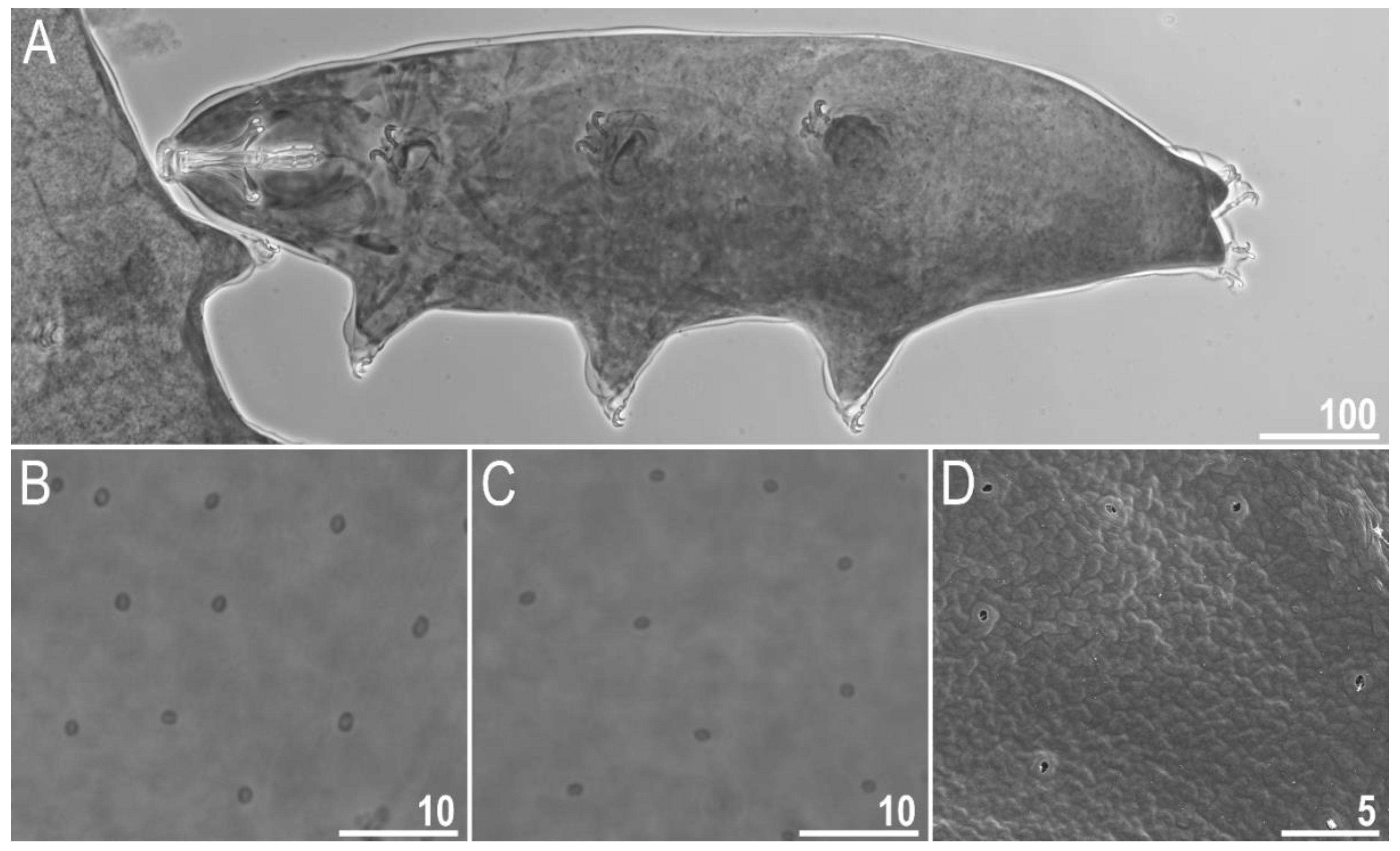
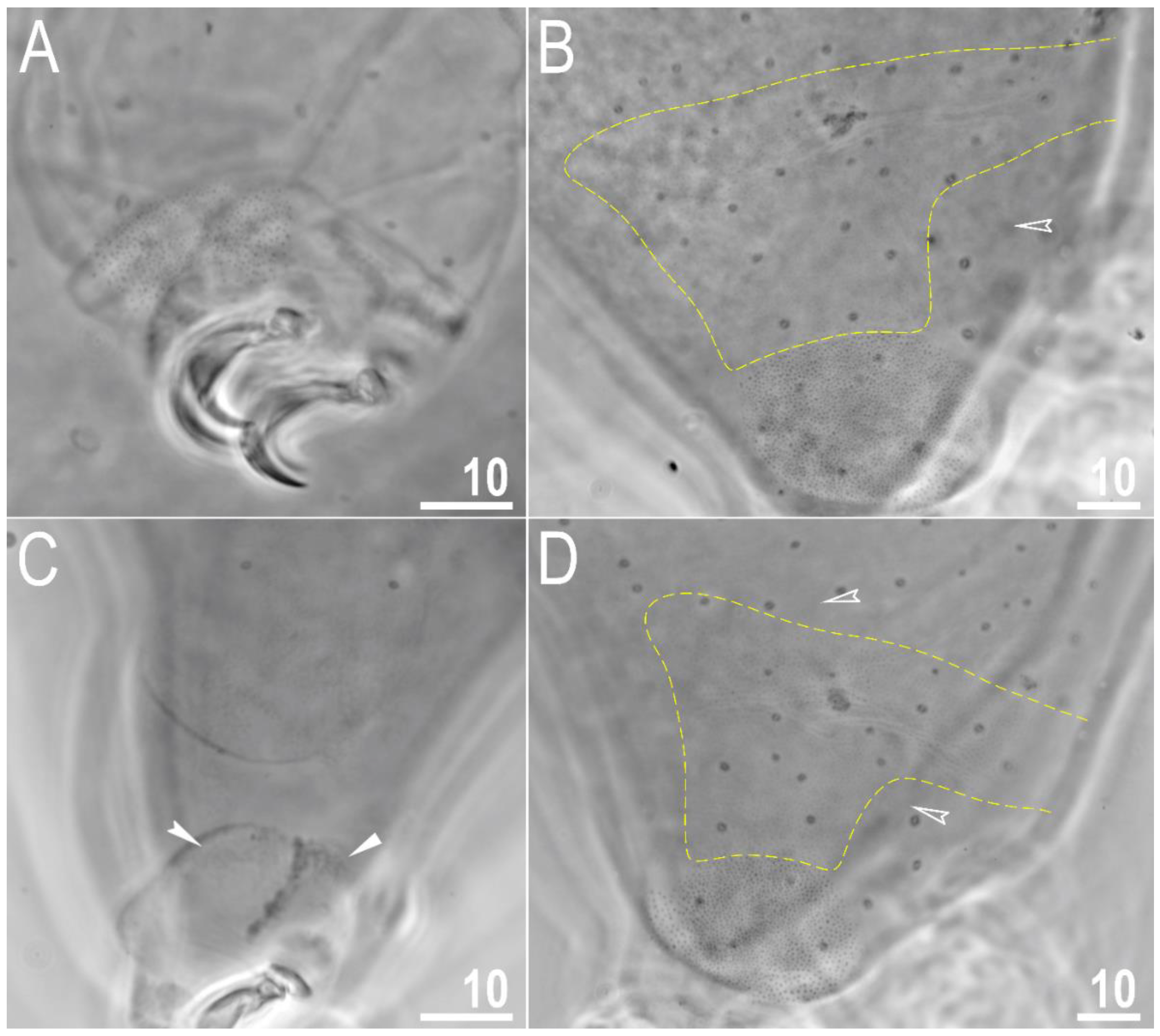
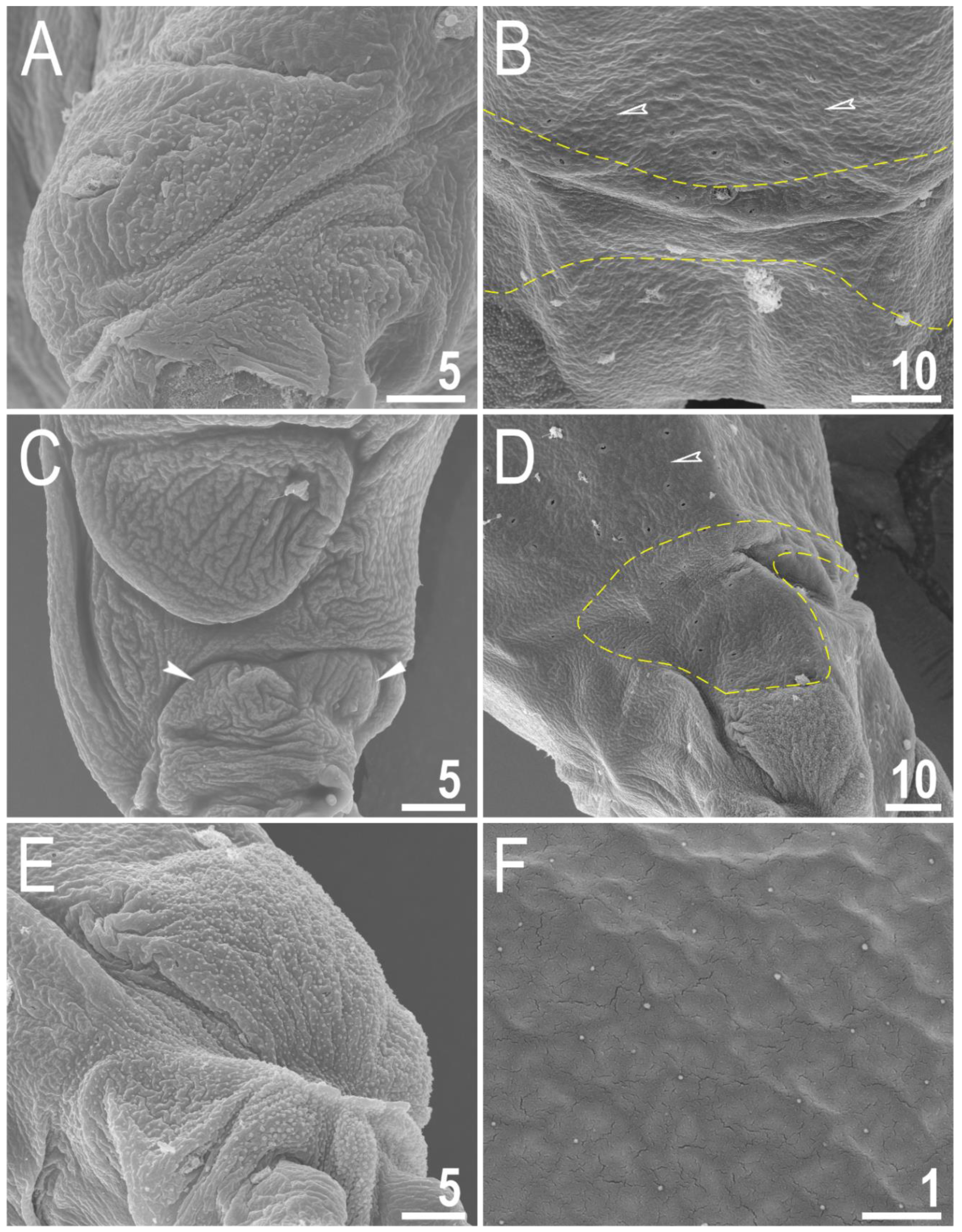
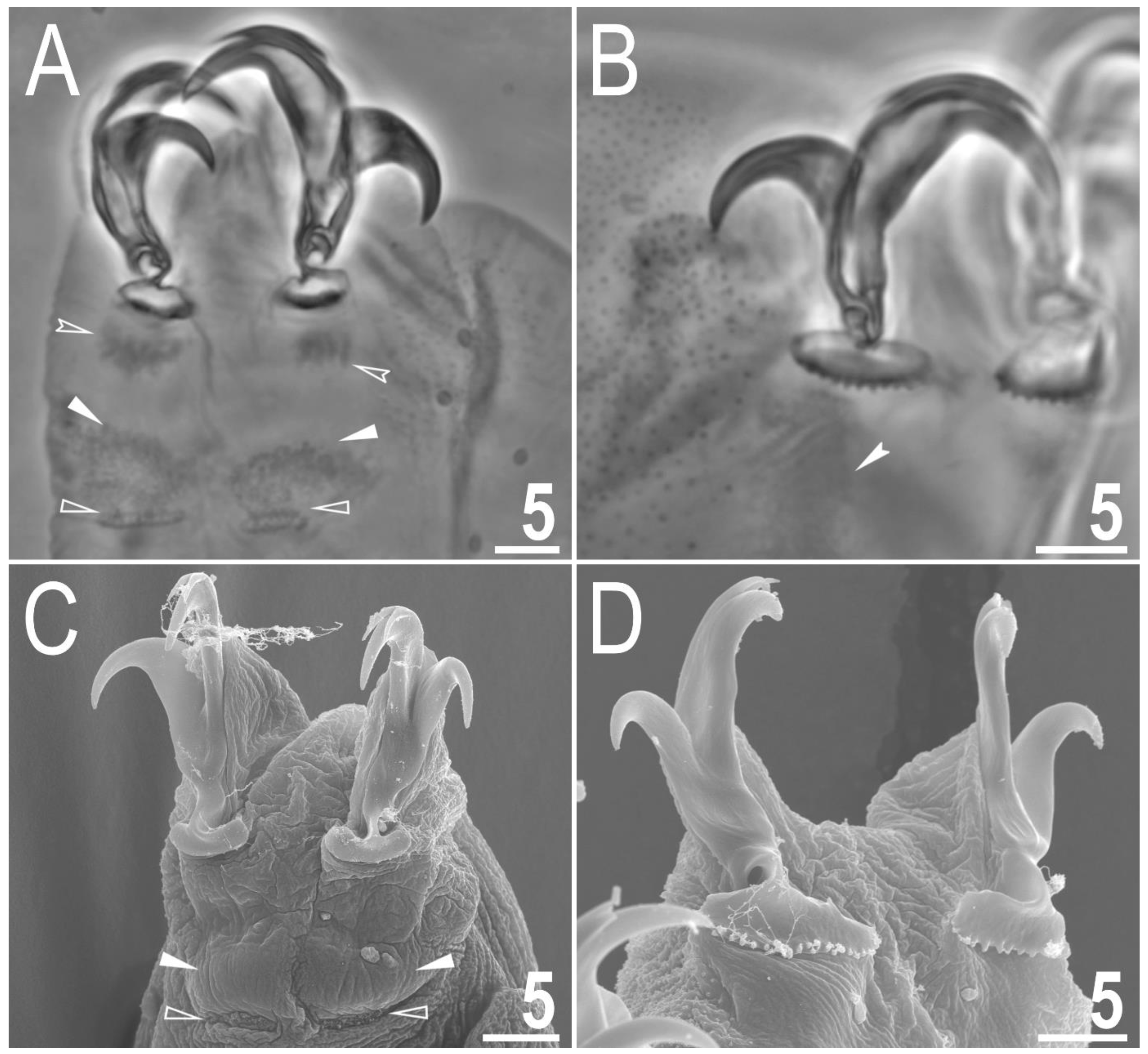
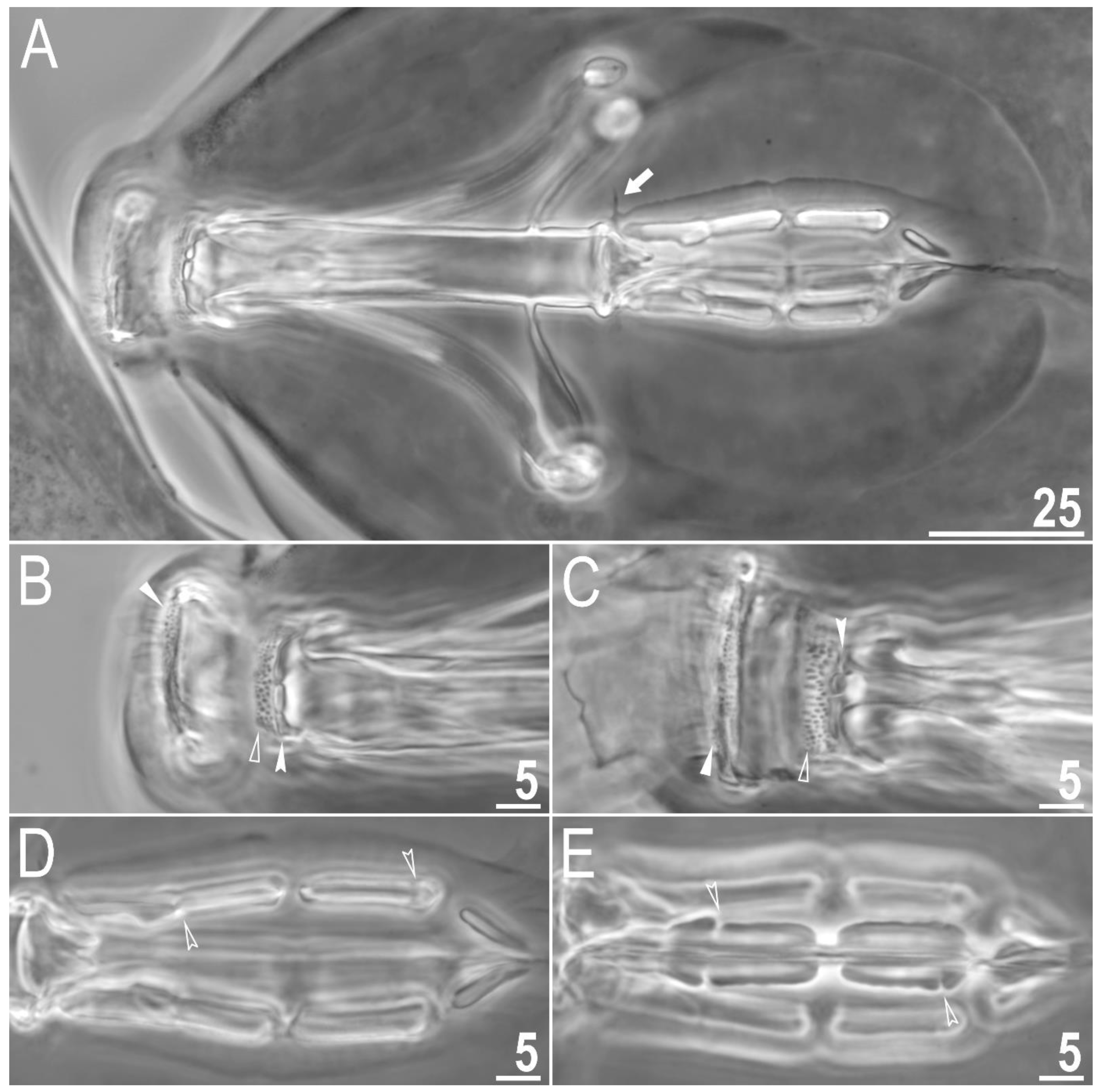
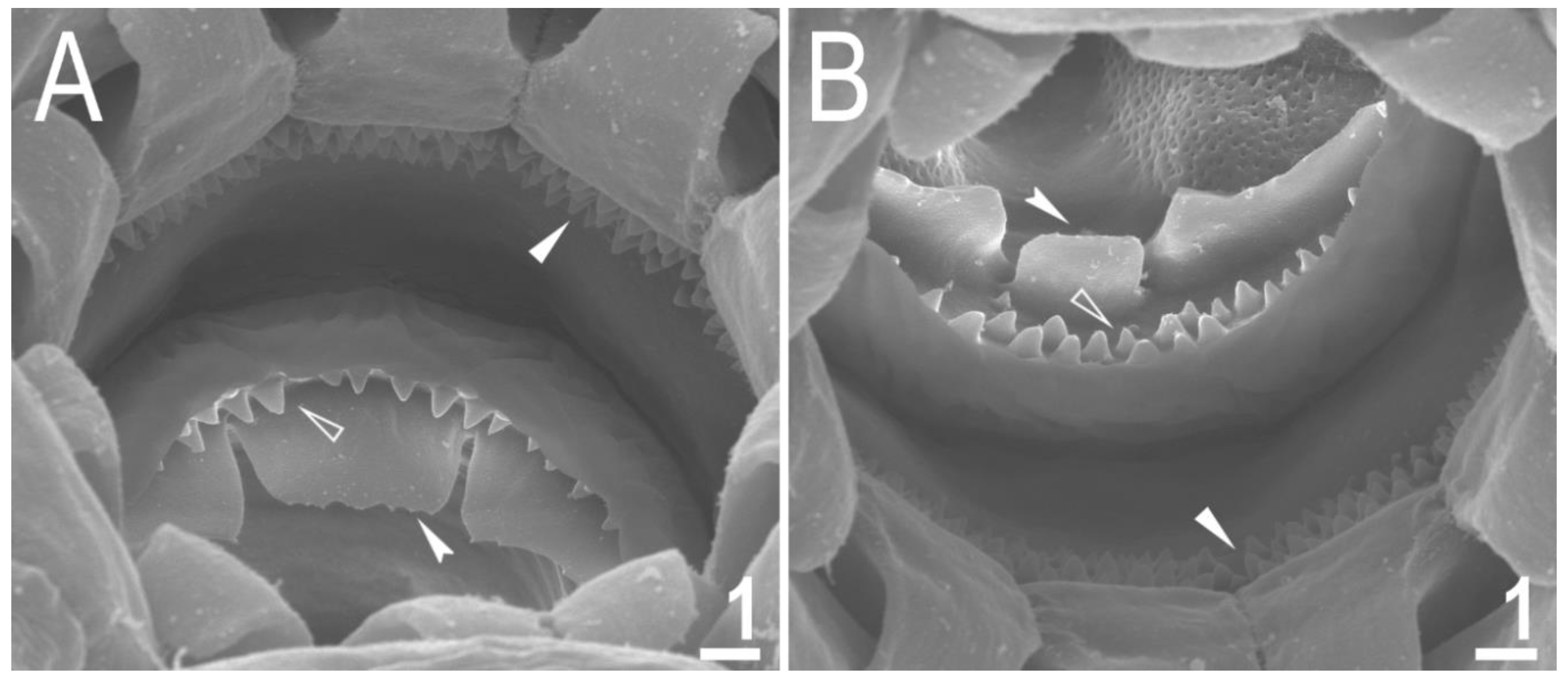
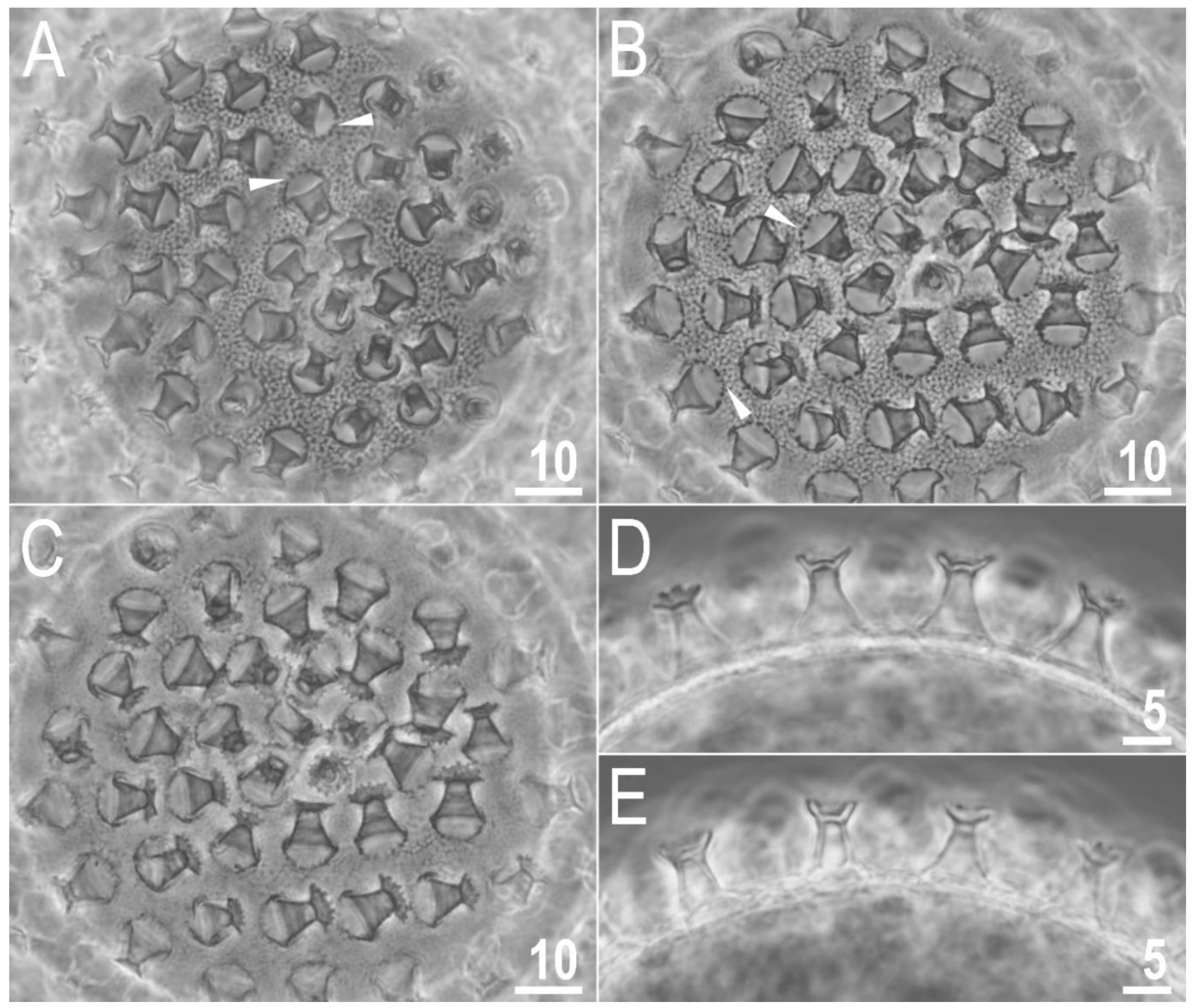
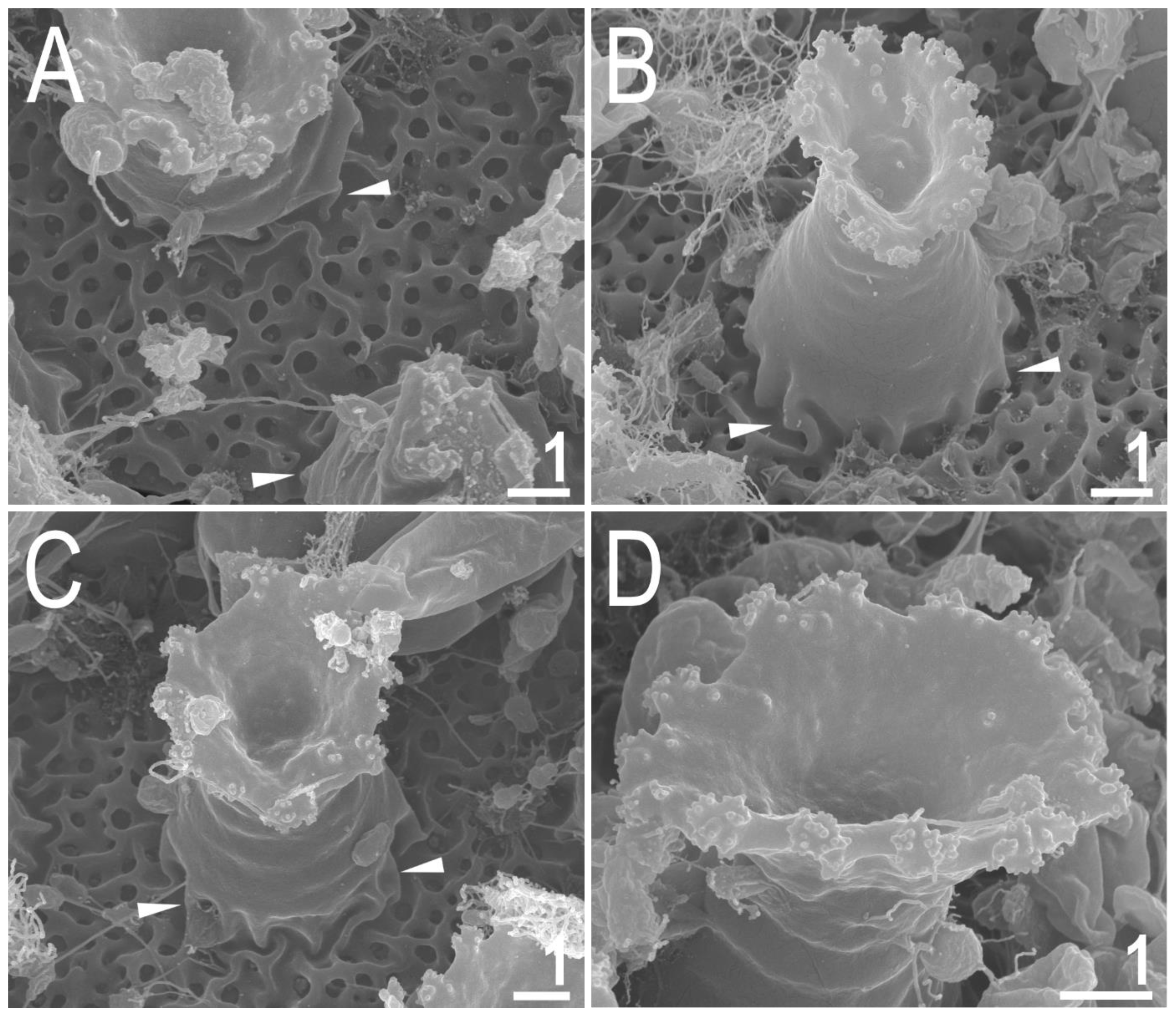
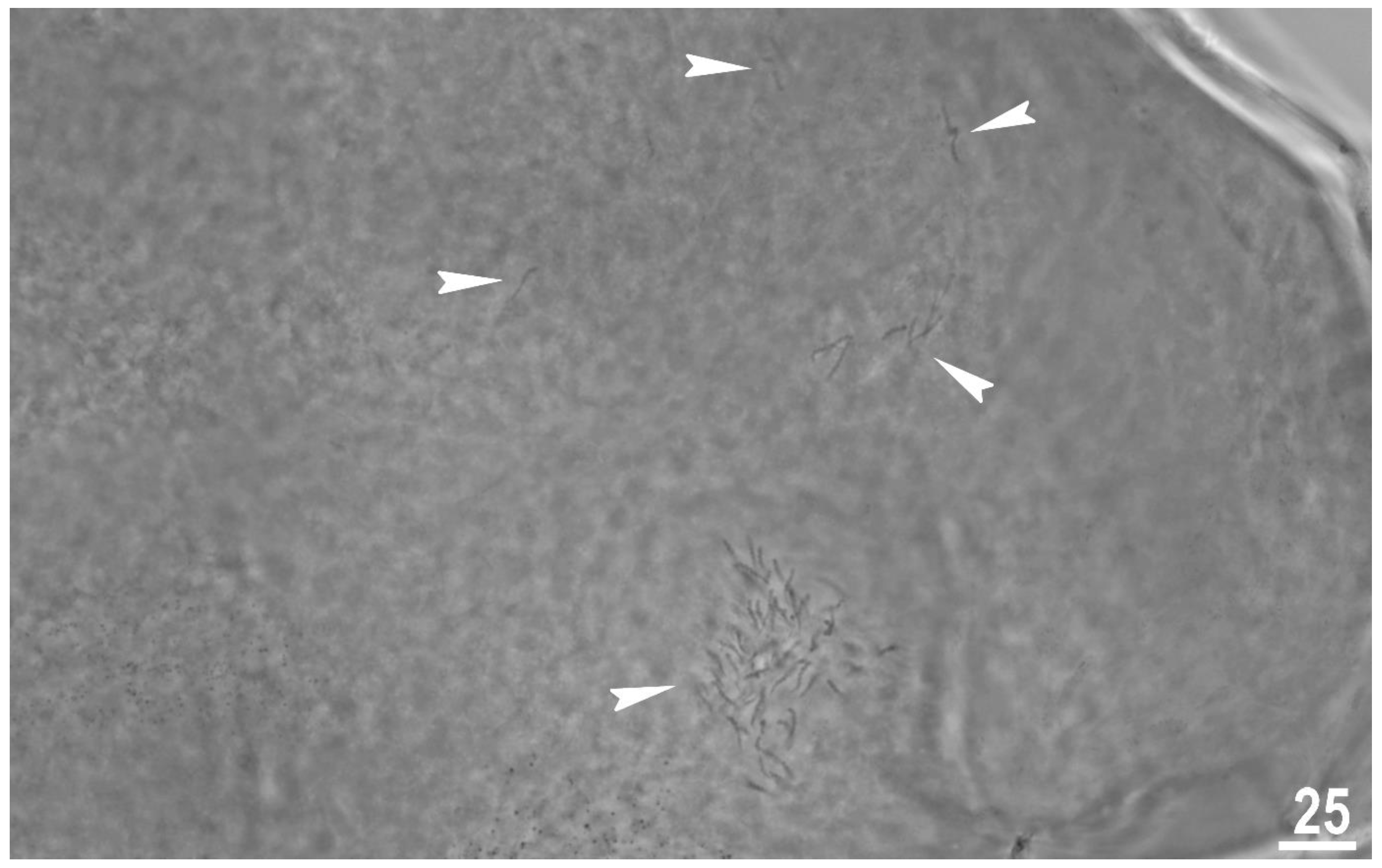
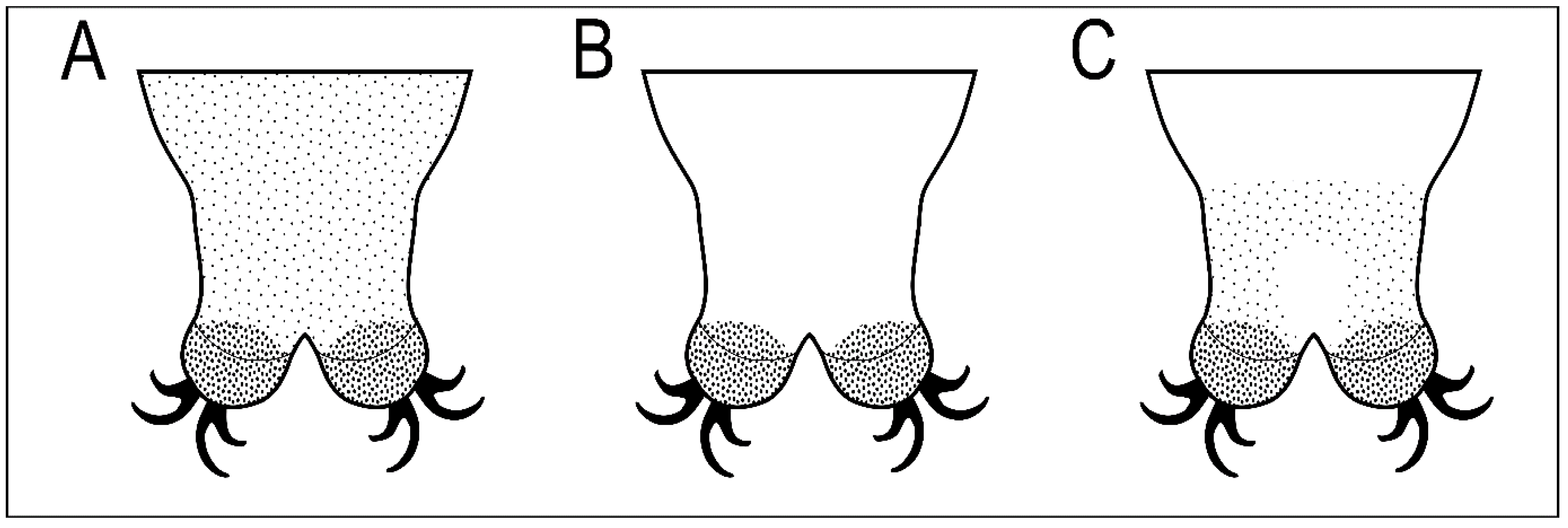
| DNA Marker | Primer Name | Primer Direction | Primer Sequence (5′-3′) | Primer Source |
|---|---|---|---|---|
| 18S rRNA | 18S_Tar_Ff1 | forward | AGGCGAAACCGCGAATGGCTC | [36] |
| 18S_Tar_Rr1 | reverse | GCCGCAGGCTCCACTCCTGG | ||
| COI | LCO1490-JJ | forward | CHACWAAYCATAAAGATATYGG | [37] |
| HCO2198-JJ | reverse | AWACTTCVGGRTGVCCAAARAATCA |
| CHARACTER | N | RANGE | MEAN | SD | Holotype | ||||||||
|---|---|---|---|---|---|---|---|---|---|---|---|---|---|
| µm | pt | µm | pt | µm | pt | µm | pt | ||||||
| Body length | 20 | 593 | – | 1061 | 995 | – | 1489 | 848 | 1294 | 108 | 120 | 902 | 1348 |
| Buccal tube | |||||||||||||
| Buccal tube length | 20 | 59.3 | – | 71.4 | – | 65.4 | – | 3.1 | – | 66.9 | – | ||
| Stylet support insertion point | 20 | 48.0 | – | 57.5 | 79.0 | – | 81.6 | 52.6 | 80.5 | 2.4 | 0.6 | 53.4 | 79.8 |
| Buccal tube external width | 20 | 10.4 | – | 13.1 | 17.1 | – | 19.7 | 12.1 | 18.6 | 0.7 | 0.7 | 12.4 | 18.5 |
| Buccal tube internal width | 20 | 8.4 | – | 10.9 | 13.7 | – | 16.6 | 9.7 | 14.8 | 0.7 | 0.8 | 10.1 | 15.1 |
| Ventral lamina length | 17 | 35.7 | – | 42.4 | 54.4 | – | 66.4 | 38.7 | 59.1 | 2.0 | 3.0 | 38.7 | 57.8 |
| Placoid lengths | |||||||||||||
| Macroplacoid 1 | 20 | 19.9 | – | 27.5 | 33.3 | – | 41.9 | 24.0 | 36.7 | 2.1 | 2.1 | 25.6 | 38.3 |
| Macroplacoid 2 | 20 | 12.6 | – | 16.1 | 20.3 | – | 23.8 | 14.4 | 22.0 | 1.1 | 1.1 | 15.7 | 23.5 |
| Microplacoid | 20 | 5.8 | – | 9.4 | 9.0 | – | 14.7 | 8.0 | 12.2 | 0.8 | 1.1 | 8.3 | 12.4 |
| Macroplacoid row | 20 | 34.3 | – | 55.1 | 57.3 | – | 81.1 | 40.9 | 62.4 | 4.4 | 5.1 | 43.4 | 64.9 |
| Placoid row | 20 | 43.1 | – | 53.9 | 64.5 | – | 81.1 | 49.8 | 76.1 | 3.8 | 4.1 | 53.5 | 80.0 |
| Claw I heights | |||||||||||||
| External primary branch | 20 | 14.1 | – | 19.4 | 23.7 | – | 27.5 | 17.1 | 26.1 | 1.3 | 1.0 | 17.8 | 26.6 |
| External secondary branch | 18 | 11.7 | – | 15.6 | 18.6 | – | 22.0 | 13.6 | 20.8 | 1.0 | 0.9 | 14.1 | 21.1 |
| Internal primary branch | 20 | 12.9 | – | 17.0 | 21.6 | – | 25.2 | 15.5 | 23.7 | 1.1 | 1.1 | 15.5 | 23.2 |
| Internal secondary branch | 17 | 10.3 | – | 13.2 | 16.8 | – | 20.1 | 12.1 | 18.6 | 0.7 | 0.9 | 12.8 | 19.1 |
| Claw II heights | |||||||||||||
| External primary branch | 20 | 14.2 | – | 19.6 | 23.8 | – | 28.2 | 17.5 | 26.8 | 1.3 | 1.0 | 18.6 | 27.8 |
| External secondary branch | 17 | 12.6 | – | 15.4 | 19.7 | – | 23.0 | 14.1 | 21.4 | 0.8 | 0.9 | 15.4 | 23.0 |
| Internal primary branch | 20 | 12.9 | – | 16.6 | 21.6 | – | 25.6 | 15.5 | 23.7 | 1.0 | 1.0 | 15.8 | 23.6 |
| Internal secondary branch | 19 | 10.5 | – | 14.3 | 17.4 | – | 21.7 | 12.8 | 19.4 | 0.9 | 1.0 | 13.3 | 19.9 |
| Claw III heights | |||||||||||||
| External primary branch | 20 | 13.9 | – | 20.2 | 23.3 | – | 28.9 | 17.7 | 27.1 | 1.3 | 1.2 | 17.8 | 26.6 |
| External secondary branch | 17 | 12.2 | – | 16.0 | 20.6 | – | 23.0 | 14.2 | 21.7 | 0.9 | 0.7 | 14.4 | 21.5 |
| Internal primary branch | 20 | 12.9 | – | 17.9 | 21.6 | – | 25.9 | 15.6 | 23.9 | 1.3 | 1.1 | 15.8 | 23.6 |
| Internal secondary branch | 19 | 10.9 | – | 14.9 | 18.0 | – | 21.6 | 12.8 | 19.5 | 1.0 | 0.9 | 13.0 | 19.4 |
| Claw IV heights | |||||||||||||
| Anterior primary branch | 18 | 15.5 | – | 20.0 | 25.5 | – | 30.6 | 18.2 | 27.9 | 1.2 | 1.5 | 18.0 | 26.9 |
| Anterior secondary branch | 15 | 12.3 | – | 16.4 | 19.5 | – | 24.2 | 13.8 | 21.3 | 1.0 | 1.2 | 13.6 | 20.3 |
| Posterior primary branch | 17 | 16.4 | – | 20.5 | 26.1 | – | 31.3 | 19.1 | 29.4 | 1.1 | 1.4 | 19.5 | 29.1 |
| Posterior secondary branch | 9 | 13.9 | – | 16.3 | 21.1 | – | 24.2 | 15.1 | 22.9 | 0.7 | 1.1 | 15.4 | 23.0 |
| CHARACTER | N | RANGE | MEAN | SD | ||
|---|---|---|---|---|---|---|
| Egg bare diameter | 20 | 86.0 | – | 110.1 | 97.9 | 5.3 |
| Egg full diameter | 20 | 101.0 | – | 125.6 | 114.3 | 5.6 |
| Process height | 60 | 6.5 | – | 9.3 | 8.1 | 0.8 |
| Process base width | 60 | 5.2 | – | 8.4 | 6.8 | 0.8 |
| Process base/height ratio | 60 | 67% | – | 111% | 84% | 9% |
| Terminal disc width | 60 | 4.8 | – | 8.2 | 6.3 | 0.6 |
| Inter-process distance | 60 | 2.8 | – | 6.9 | 4.6 | 0.9 |
| Number of processes on the egg circumference | 20 | 26 | – | 31 | 28.7 | 1.6 |
Publisher’s Note: MDPI stays neutral with regard to jurisdictional claims in published maps and institutional affiliations. |
© 2022 by the author. Licensee MDPI, Basel, Switzerland. This article is an open access article distributed under the terms and conditions of the Creative Commons Attribution (CC BY) license (https://creativecommons.org/licenses/by/4.0/).
Share and Cite
Stec, D. Macrobiotus rebecchii sp. nov.: A New Limno-Terrestrial and Hermaphroditic Tardigrade from Kyrgyzstan. Animals 2022, 12, 2906. https://doi.org/10.3390/ani12212906
Stec D. Macrobiotus rebecchii sp. nov.: A New Limno-Terrestrial and Hermaphroditic Tardigrade from Kyrgyzstan. Animals. 2022; 12(21):2906. https://doi.org/10.3390/ani12212906
Chicago/Turabian StyleStec, Daniel. 2022. "Macrobiotus rebecchii sp. nov.: A New Limno-Terrestrial and Hermaphroditic Tardigrade from Kyrgyzstan" Animals 12, no. 21: 2906. https://doi.org/10.3390/ani12212906
APA StyleStec, D. (2022). Macrobiotus rebecchii sp. nov.: A New Limno-Terrestrial and Hermaphroditic Tardigrade from Kyrgyzstan. Animals, 12(21), 2906. https://doi.org/10.3390/ani12212906






